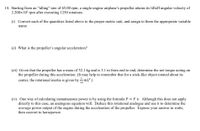Question
Hello I need help answering these parts of the question. Especially the last part. Please and thank you.

Transcribed Image Text:14. Starting from an “idling" rate of 65.00 rpm, a single-engine airplane's propeller attains its liftoff angular velocity of
2.200x103 rpm after executing 1250 rotations.
(i) Convert each of the quantities listed above to the proper metric unit, and assign to them the appropriate variable
name.
(ii) What is the propeller's angular acceleration?
(iii) Given that the propeller has a mass of 52.1 kg and is 3.1 m from end to end, determine the net torque acting on
the propeller during this acceleration. (It may help to remember that for a stick-like object rotated about its
center, the rotational inertia is given by mL?.)
(iv) One way of calculating instantaneous power is by using the formula P = F v. Although this does not apply
directly to this case, an analogous equation will. Deduce this rotational analogue and use it to determine the
average power output of the engine during the acceleration of the propeller. Express your answer in watts,
then convert to horsepower.
Expert Solution
This question has been solved!
Explore an expertly crafted, step-by-step solution for a thorough understanding of key concepts.
Step by stepSolved in 2 steps

Knowledge Booster
Similar questions
arrow_back_ios
arrow_forward_ios